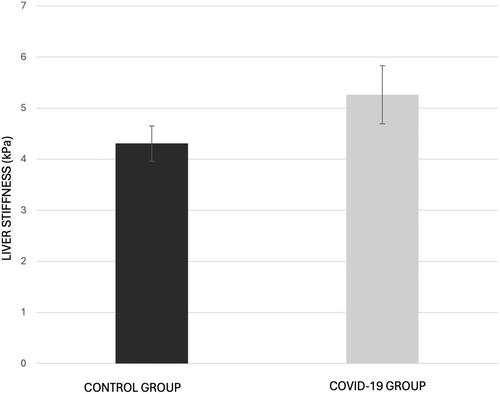Assessment of the liver with two-dimensional shear wave elastography following COVID-19 infection: A pilot study
Abstract
Introduction/Purpose
The coronavirus disease (COVID-19) is a widely spread viral infectious disease, which can impact multiple organs, including the liver. Elevated liver enzymes have been reported in COVID-19 patients; however, potential changes in liver stiffness following the viral infection remain uncertain. The main aim of this pilot study was to determine if there is a significant difference in liver stiffness between individuals who have never been infected with COVID-19 and those who had been infected with COVID-19 <6 months, experiencing only mild symptoms. The secondary aim was to compare the liver stiffness between participants infected with COVID-19 depending on the elapsed time since infection.
Methods
Two-dimensional shear wave elastography (2D-SWE) was performed prospectively on 68 participants. Thirty-four participants had been infected with COVID-19 (all for <6 months) (COVID-19 group), and another 34 had never been infected with COVID-19 (control group). The mean 2D-SWE measurements of both the COVID-19 group and the control group were compared using an independent t-test. The mean 2D-SWE measurements of the COVID-19 subgroups A (<2 months), B (2 to <4 months) and C (4 to <6 months) were compared using a one-way ANOVA test (P < 0.05).
Results
The (mean ± standard deviation) liver stiffness (kPa) of the COVID-19 group (5.26 ± 1.63 kPa) was significantly higher than the control group (4.30 ± 0.96 kPa) (P = 0.005). There was no significant difference in liver stiffness among subgroups A (5.20 ± 1.79 kPa), B (4.70 ± 1.53 kPa) and C (5.96 ± 1.48 kPa) (P = 0.143) respectively.
Discussion
The mean liver stiffness of 4.30 ± 0.96k Pa in the control group showed a high probability of being normal as per guidelines. Conversely, the mean liver stiffness of 5.26 ± 1.63 kPa in the COVID-19 group exhibited a statistically significant increase compared to the control group. However, compensated advanced chronic liver disease was ruled out without other known clinical signs, as per guidelines.
Conclusion
A statistically significant increase in liver stiffness value was observed in the post-COVID-19 infection group compared to the group who had never been infected. This highlights the potential for short-term impact on liver stiffness associated with COVID-19 infection. However, it is unclear if these changes in liver stiffness are associated with liver injury. Further study is warranted to investigate the effects of COVID-19 infection and its long-term impact on the liver.


 求助内容:
求助内容: 应助结果提醒方式:
应助结果提醒方式:


